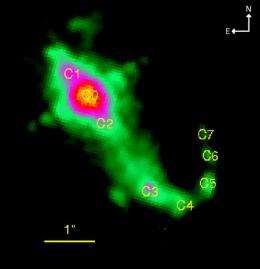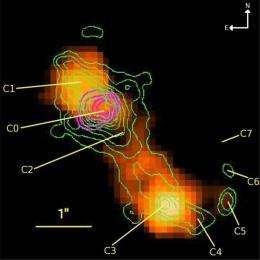Symbiotic Stars

(PhysOrg.com) -- Many, perhaps even most stars, are members of binaries -- two stars that orbit each other. Symbiotic stars are a small subset of binaries with an attitude: they display characteristic, dramatic, episodic changes in the spectra of their light because (it is thought) one star of pair is a very hot, small star while the other is a cool giant.
Cool giant stars are known to have winds. If material in the wind of a giant accretes onto the hot companion, the latter will erupt with bright emission in the visible and occasionally in X-rays. At least, this is what astronomers suspect is happening. Besides wanting to understand what powers these strangely variable objects, astronomers also want to understand how they are formed, and why more binary stars are not symbiotics.
The symbiotic star CH Cygni is only about 800 light-years away from us, and so can be more easily studied in detail than most other symbiotics (the "CH" indicates it is a relatively bright variable star in the visible). It also happens that CH Cygni has a jet, detected at both radio and X-ray wavelengths, that was known to extend from the star to a distance of 750 AU (about twenty times the mean distance of Pluto from the sun). A team of four CfA astronomers, Margarita Karovska, Terrance Gaetz, John Raymond, and Nicholas Lee, together with two colleagues, used the Chandra X-ray Observatory, the Hubble Space Telescope, and the radio's Very Large Array to study this star in a coordinated set of observations.

The scientists find that the jet shows clumps of material along its curved structure that are evidence of episodic activity -- perhaps the result of the jet's changing direction, or perhaps occasional mass ejections from the star. The clumped gas appears to be shocked, possibly the result of interactions between the jet and the cool star's wind. The team calculates the shocks have velocities of as much as 1200 kilometers per second. They also report finding that the jet has about doubled its length in the past nine years. The new results highlight the importance of jet activity as well as accretion in the larger picture of understanding the erratic behavior of symbiotic stars.
Provided by Harvard-Smithsonian Center for Astrophysics



















